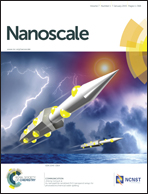Ultra-long zinc oxide nanowires and boron doping based on ionic liquid assisted thermal chemical vapor deposition growth†
Abstract
Ionic liquid assisted growth of ultra-long ZnO nanowires from thermal chemical vapor deposition and the incorporation of dopants into the ZnO lattice have been investigated. We find that decomposed components of the ionic liquid at higher temperatures facilitate ultra-long vapor–liquid–solid ZnO nanowires that exhibit an unusual a-axis orientation. In particular, the ionic liquid BMImBF4 has been studied and the mechanism of the nanowire growth model in response to the use of the ionic liquid has been explained. We show that boron which is part of the investigated ionic liquid incorporates into the ZnO lattice and serves as a donor source. Electrical measurements were conducted and have shown an enhanced electrical conductivity (ρ = 0.09 Ω cm) when using the ionic liquid assisted growth approach. This work represents a step towards the controlled doping for designing future nanowire devices.


 Please wait while we load your content...
Please wait while we load your content...